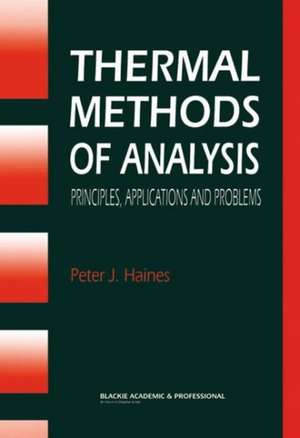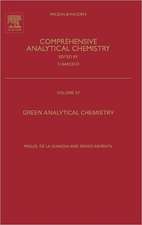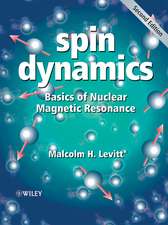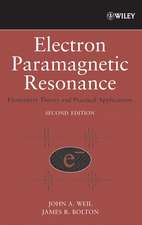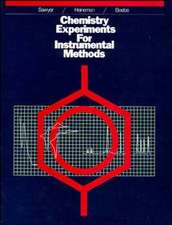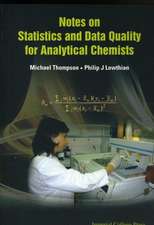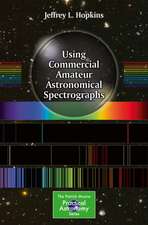Thermal Methods of Analysis: Principles, Applications and Problems
Autor P. J. Hainesen Limba Engleză Paperback – 31 dec 1994
Preț: 644.30 lei
Preț vechi: 758.01 lei
-15% Nou
Puncte Express: 966
Preț estimativ în valută:
123.29€ • 129.05$ • 102.61£
123.29€ • 129.05$ • 102.61£
Carte tipărită la comandă
Livrare economică 31 martie-14 aprilie
Preluare comenzi: 021 569.72.76
Specificații
ISBN-13: 9780751400502
ISBN-10: 0751400505
Pagini: 286
Ilustrații: XII, 286 p.
Dimensiuni: 178 x 254 x 16 mm
Greutate: 0.53 kg
Ediția:1995
Editura: SPRINGER NETHERLANDS
Colecția Springer
Locul publicării:Dordrecht, Netherlands
ISBN-10: 0751400505
Pagini: 286
Ilustrații: XII, 286 p.
Dimensiuni: 178 x 254 x 16 mm
Greutate: 0.53 kg
Ediția:1995
Editura: SPRINGER NETHERLANDS
Colecția Springer
Locul publicării:Dordrecht, Netherlands
Public țintă
ResearchCuprins
1 Introduction to thermal methods.- 1.1 Introduction.- 1.2 Historical development.- 1.3 Definitions.- 1.4 Computers and thermal methods.- 1.5 Factors affecting thermal analysis results.- 1.6 Simultaneous and complementary techniques.- 1.7 Problems.- References.- General Bibliography.- 2 Thermogravimetry.- 2.1 Introduction.- 2.2 Historical.- 2.3 Definition of thermogravimetry.- 2.4 Apparatus.- 2.5 Kinetics of reactions.- 2.6 Applications of thermogravimetry.- 2.7 Controlled rate thermogravimetry and Hi-Res• TGA.- 2.8 Problems.- References.- 3 Differential thermal analysis and differential scanning calorimetry.- 3.1 Introduction.- 3.2 Historical.- 3.3 Definitions.- 3.4 Apparatus.- 3.5 Theory of DTA and DSC.- 3.6 Heat flux DSC.- 3.7 Power-compensated DSC.- 3.8 Calibration.- 3.9 Applications.- 3.11 Problems.- References.- 4 Thermomechanical, dynamic mechanical and associated methods.- 4.1 Introduction.- 4.2 Definitions.- 4.3 Thermomechanical analysis.- 4.4 Dynamic mechanical analysis.- 4.5Dielectric thermal analysis.- 4.6 Thermally stimulated current analysis and relaxation map analysis.- 4.7 Problems.- References.- 5 Simultaneous techniques and product analysis.- 5.1 Introduction.- 5.2 Simultaneous thermal analysis.- 5.3 Evolved gas analysis.- 5.4 Detection and identification of evolved gases.- 5.5 Infrared and simultaneous TA-infrared.- 5.6 Infrared product analysis.- 5.7 Thermomicroscopy.- 5.8 X-ray methods.- 5.9 Electron microscopy and associated techniques.- 5.10 Conclusion.- 5.11 Less common thermal analysis techniques.- 5.12 Problems.- References.- 6 Problem solving and applications of thermal methods.- List of examples.- Problems/Solutions.- 6.1 Inorganic materials.- 6.2 Polymeric materials.- 6.3 Fine chemicals and pharmaceuticals.- 6.4 Other materials.- References.- Appendix: Solutions to problems in Chapters 1-5.
Recenzii
The book represents excellent value for money...and should be invaluable in setting examination questions or in tutorial work. A copy of the book should be available in every chemistry library. - Education in Chemistry.; ...this will probably become the standard textbook for undergraduate courses in thermal analysis. - Chemistry and Industry; This is an excellent introductory text to thermal methods of analysis, with an easily read writing style...In particular academics and students would find this text a very useful addition to their bookshelves, but it would also be useful to graduate scientists and engineers who want to find out what relevance thermal methods of analysis have to their field. - Trends in Analytical Chemistry.
